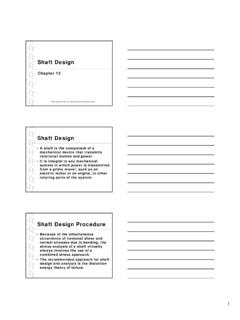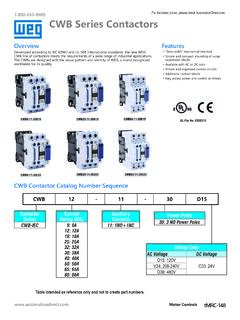Transcription of Electrical Symbols and Line Diagrams - University of Florida
1 1 Electrical Symbols and Line DiagramsChapter 3 Material taken from Chapter 3 of Electric Motor Controls, G. Rockis, 2001 One-Line Diagrams One-line diagram a diagram that uses single lines and graphic Symbols to indicate the path and components of an Electrical circuit. One-line Diagrams are used when information about a circuit is required but detail of the actual wire connections and operation of the circuit are Diagrams A line (ladder) diagram is a diagram that shows the logic of an Electrical circuit or system using standard Symbols . A line diagram is used to show the relationship between circuits and their components but not the actual location of the components. Line Diagrams provide a fast, easy understanding of the connections and use of Motor Controls, G. Rockis, 20013 Electric Motor Controls, G. Rockis, 2001 Wiring Diagrams Wiring (connection) diagram a diagram that shows the connection of an installation or its component devices or parts.
2 Wiring Diagrams show, as closely as possible, the actual location of each component in a circuit, including the control circuit and the power Motor Controls, G. Rockis, 2001 Manual Control Circuits Manual control circuit any circuit that requires a person to initiate an action for the circuit to operate. A line diagram may be used to illustrate a manual control circuit of a pushbutton controlling a pilot light. A line diagram may be used to illustrate the control and protection of a 1 motor using a manual starter with overload Motor Controls, G. Rockis, 2001 Electric Motor Controls, G. Rockis, 20016 Automatic Control Circuits Automatically-controlled devices have replaced many jobs that were once performed manually. As a part of automation, control circuits are designed to replace manual Motor Controls, G. Rockis, 20017 magnetic Control Circuits Although manual controls are compact and sometimes less expensive than magnetic controls, industrial and commercial installations often require that Electrical control equipment be located in one area while the load device is located in another.
3 Solenoids, contactors , and magnetic motor starters are used for remote control of A solenoid is an Electrical device that converts Electrical energy into a linear mechanical Motor Controls, G. Rockis, 20018 Electric Motor Controls, G. Rockis, 2001 contactors Contactor a control device that uses a small control current to energize or de-energize the load connected to it. A contactor does not include overload protection. A contactor has a frame, plunger, and coil like a The action of the plunger, however, is directed to close (or open) sets of contacts. The closing of the contacts allows Electrical devices to be controlled from remote Motor Controls, G. Rockis, 200110 Electric Motor Controls, G. Rockis, 2001 magnetic Motor Starters A magnetic motor starter is an electrically-operated switch (contactor) that includes motor overload protection. magnetic motor starters are identical to contactors except that they have overloads attached to Motor Starters The overloads have heaters or electronic overloads (located in the power circuit) which sense excessive current flow to the motor.
4 The heaters open the NC overload contacts (located in the control circuit) when the overload becomes dangerous to the motor. Electric Motor Controls, G. Rockis, 200112 Logic Applied to Line DiagramsChapter 4 Material taken from Chapter 4 of Electric Motor Controls, G. Rockis, 2001 Basic Rules The Electrical industry has established a universal set of Symbols and rules on how line Diagrams (circuits) are laid Load Per Line No more than one load should be placed in any one circuit line between L1 and L2. A pilot light can be connected into a circuit with single-pole Motor Controls, G. Rockis, 200114 One Load Per Line Two loads must not be connected in series on one line of a line diagram. If the two loads are connected in series, then the voltage between L1 and L2 must divide across both loads when S1 is closed. The result is that neither device receives the entire 120 V necessary for proper Load Per Line Loads must be connected in parallel when more than one load must be connected in the line diagram.
5 This circuit has two lines, one for the pilot light and one for the Motor Controls, G. Rockis, 200115 Load Connections A load is the Electrical device in the line diagram that uses the Electrical power from L1 to L2. Control relay coils, solenoids, and pilot lights are loads that are connected directly or indirectly to Motor Controls, G. Rockis, 200116 Load Connections magnetic motor starter coils are connected to L2 indirectly through normally closed overload contacts. Anywhere from 1 to 3 NC overload contacts are shown between the starter and L2 in all line Diagrams . To avoid confusion, it is common practice to draw one set of NC overload contacts and mark these contacts all overloads (OLs).Electric Motor Controls, G. Rockis, 200117 Control Device Connections Control devices are connected between L1 and the operating coil (or load). Operating coils of contactors and starters are activated by control devices such as pushbuttons, limit switches, and pressure devices are connected between L1 andthe operating Motor Controls, G.
6 Rockis, 200118 Control Device Connections Each line includes at least one control device. The operating coil is ON all the time if no control device is included in a line. A circuit may contain as many control devices as is required to make the operating coil function as Motor Controls, G. Rockis, 200119 Line Number Reference Each line in a line diagram should be numbered starting with the top line and reading Motor Controls, G. Rockis, 2001 Numerical Cross-Reference Systems Numerical cross-reference systems are required to trace the action of a circuit in complex line Diagrams . Common rules help to quickly simplify the operation of complex Contacts Relays, contactors , and magnetic motor starters normally have more than one set of auxiliary contacts. These contacts may appear at several different locations in the line diagram. Numerical cross-reference systems quickly identify the location and type of contacts controlled by a given device.
7 A numerical cross-reference system consists of numbers in parenthesis to the right of the line Motor Controls, G. Rockis, 200121NC Contacts In addition to NO contacts, there are also NC contacts in a circuit. To differentiate between NO and NC, NC contacts are indicated as a number which is Motor Controls, G. Rockis, 200122 Wire-Reference Numbers Each wire in a control circuit is assigned a reference point (number) on a line diagram to keep track of the different wires that connect the components in the circuit. Each reference point is assigned a reference number. Reference numbers are normally assigned from the top left to the bottom Motor Controls, G. Rockis, 200123 Manufacturer s Terminal Numbers Manufacturers of Electrical relays, timers, counters, etc., include numbers on the terminal connection points. These terminal numbers are used to identify and separate the different component parts (coil, NC contacts, etc) included on the individual pieces of equipment.
8 Manufacturer s terminal numbers are often added to a line diagram after the specific equipment to be used in the control circuit is identified. Electric Motor Controls, G. Rockis, 200124 Signals, Decisions, and Action A circuit must respond as designed, without any changes. To accomplish this consistency, all control circuits are composed of three basic sections: the signals, the decisions, and the action Motor Controls, G. Rockis, 200125 Signals A signal starts or stops the flow of current by closing or opening the control device s contacts. Current is allowed to flow through the control device if the contacts are closed. Current is not allowed to flow through the control device if the contacts are Pushbuttons, limit switches, flow switches, foot switches, temperature switches, and pressure switches may be used as the signal section of a control All signals depend on some condition that must take place.
9 This condition can be manual, mechanical, or automatic. A manual condition is any input into the circuit by a person. Foot switches and pushbuttons are control devices that respond to a manual A mechanical condition is any input into the circuit by a mechanically moving part. A limit switch is a control device that responds to a mechanical An automatic condition is any input which responds automatically to changes in a system. Flow switches, temperature switches, and pressure switches respond to automatic The decision section of a circuit determines what work is to be done and in what order the work is to occur. The decision section of a circuit adds, subtracts, sorts, selects, and redirects the signals from the control devices to the The way the control devices are connected into the circuit gives the circuit logic. The basic logic functions are AND, OR, NOT, NOR, and NAND logic.
10 The decision section of the circuit accepts informational input (signals), makes logical decisions based on the way the control devices are connected into the circuit, and provides the output signal that controls the Once a signal is generated and the decision has been made within a circuit, some action (work) should result. In most cases it is the operating coil in the circuit which is responsible for initiating the This action is direct when devices such as motors, lights, and heating elements are turned ON as a direct result of the signal and the decision. This action is indirect when the coils in solenoids, magnetic starters, and relays are Functions Control devices such as pushbuttons, limit switches, and pressure switches are connected into a circuit so that the circuit can function in a predetermined manner. All control circuits are basic logic functions.






